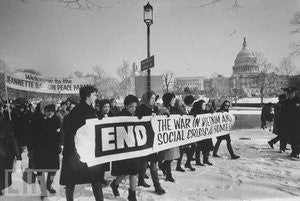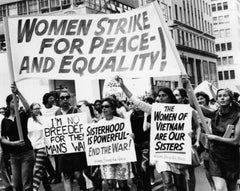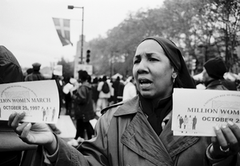A Long Time Coming
 We’ve been thinking about these women who organized, painted signs, and demanded that things change. These were our mothers, grandmothers, and great-grandmothers. As we turn our heads towards the upcoming Women’s March on Washington, we took a look at these movements over the generations.
We’ve been thinking about these women who organized, painted signs, and demanded that things change. These were our mothers, grandmothers, and great-grandmothers. As we turn our heads towards the upcoming Women’s March on Washington, we took a look at these movements over the generations.
The following is an incomplete and imperfect account of a few meaningful marches. Out of respect for the sisters that have been walking this walk well before us, we acknowledge the generations of hard work that have made today’s conversations possible.

1913 - March 3
Woman Suffrage Parade.
5,000 march to support women's voting rights the day President-elect Woodrow Wilson arrived for his swearing in the next day. It took 7 more years (after 70 years of activism) for women (some) to begin to gain the right to vote.
When were voting rights granted to ALL women, you ask!?
In 1920, white women got the right to vote. In 1924-1947 Native American women got the right to vote. In 1952 Asian-American women got the right to vote. Finally, in 1966, African American women got the right to vote.
 Jeannette Rankin Brigade1968 - January 15
Jeannette Rankin Brigade1968 - January 15
At age 87, Jeannette Rankin led the march of a group of 5,000 women who came together from women's pro-peace organizations, including the Women's International League for Peace and Freedom and Women Strike for Peace, joined together in strong female opposition to the Vietnam War.

1970 - August 26
Women's Strike for Equality
This nationwide march, which exemplified cross-generational female solidarity, drew around 20,000 women protesters in Washington D.C., and significantly raised the visibility of the feminist movement.
“The huge number of marchers, young and old, made a convincing case that this was a movement for everyone.” - Joyce Antler/ historian
 March For Women's Lives - Reproductive Rights Rally 1986 - March 9
March For Women's Lives - Reproductive Rights Rally 1986 - March 9
The National Organization for Women (NOW) organized the 1986 'March For Women's Lives,' a massive pro-choice rally held in Washington D.C. on 9 March 1986. It was the largest march for women's rights at the time. The event drew 125,000 in D.C.
 Million Woman March1997 - October 25
Million Woman March1997 - October 25
An estimated 750,000 African American women gathered together to focus on their trials, circumstances, and successes. The march was designed to inspire African American women across the nation to work for their own improvement as well as that of their communities.
 March for Women's Lives.2004 - April 25
March for Women's Lives.2004 - April 25
A pro-choice march which succeeded in drawing an attendance that may have reached as high as 1,100,000 . Linked by a common goal; seven different women's groups joined together. All were committed to drawing a broadly diverse crowd to D.C. to protect the rights and lives of women and girls of all ages, races, ethnicities, economic classes,religious beliefs, sexual orientations and abilities.

2017 - January 21
Women’s March on Washington
According to the main Facebook event page, the march is meant to be a celebration of women’s rights and a statement to the incoming president "that women's rights are human rights." This is Herstory in the making. Find a march near you here: Sister Marches
So why march? Because there is still work to be done, and no one is going to do our work for us. When we lean-in together, our visions of the future become more possible.
Links to visit:
NOW (National Organization for Women): History of women’s marches and mass actions
ARTICLE: It started with a retiree. Now the Women’s March could be...
ARTICLE: Explaining the Women's March on Washington
ARTICLE: Million Women March 1997













